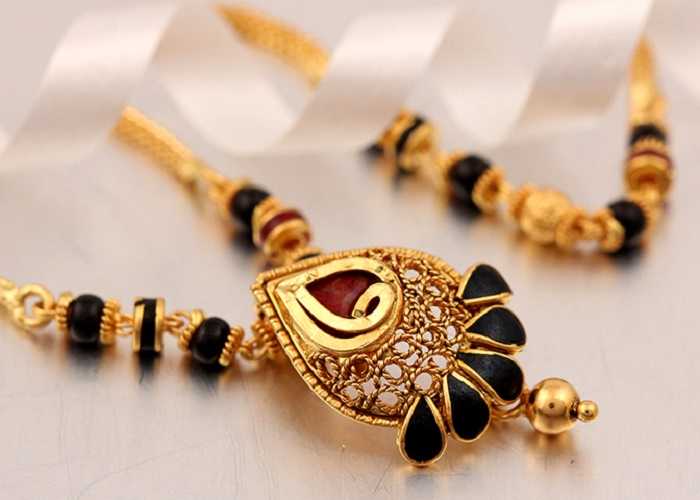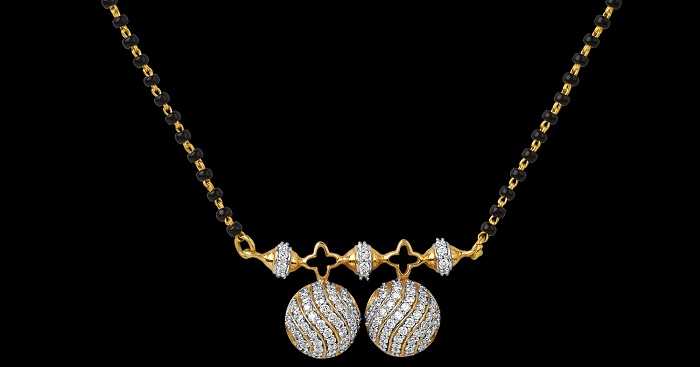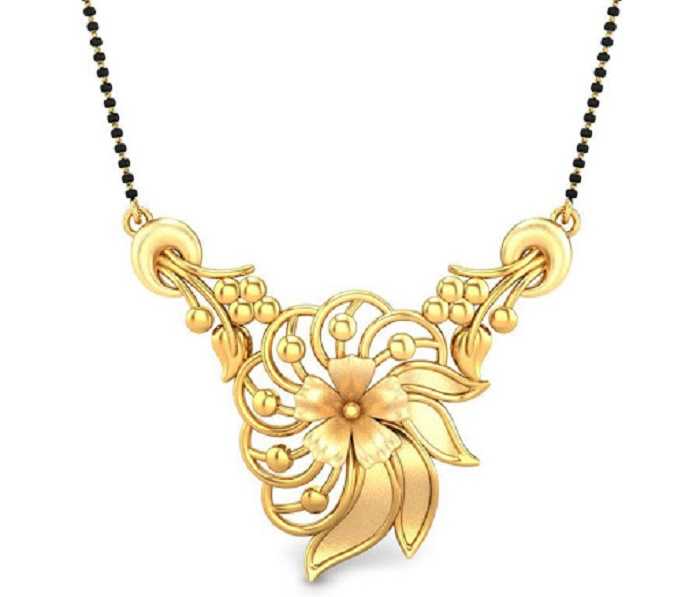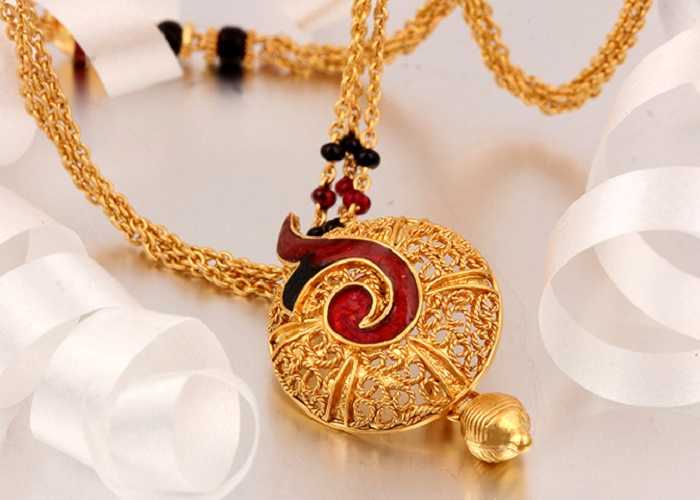
Image Credit: muktaeventmanagers.com
One of the most sacred customs in Hindu weddings is tying the mangalsutra. A mangalsutra is basically a black and gold beaded necklace with a gold or diamond pendant. Mangalsutra carries immense importance in Hindu weddings as well as in the lives of Hindu married women. It is tied around the neck of the bride by the groom during the wedding rituals. It is a symbol of marriage and is worn by the bride until her husband's death. The word mangalsutra can be deciphered as 'sacred thread or cord'; as 'mangal' means auspicious and 'sutra' means thread or cord. Though in appearance it looks like a jewelry item, it is definitely much more than that. The concept is thought to have originated in South India, where it is known as thali or thaaly or maangalyam. It is a yellow thread painted with turmeric paste and is tied around the bride's neck with three knots.
It is worn as a symbol of marital dignity and chastity. It is a promise from a husband to his wife that they will always stay together. It depicts the union of the husband and the wife and protects them from evil. The mangalsutra occupies a significant position in Hindu marriages and rituals. In modern times, mangalsutra has also become a fashion statement. Women now go for exclusive designs and are ready to experiment. Thanks to the soap operas on the television that have significantly contributed to the change in the mindset.
The shape and size of mangalsutra may vary from state to state and region to region. In north India, it is a necklace with black and gold beads with either a gold or diamond pendant. In the west, it consists of two gold rounds with black beads.

Wearing the Mangalsutra
The Mangalsutra is not just a piece of jewelry that a woman wears, but it is considered to be one of the three most important ‘Soubagyalankar’ (Soubhagya = marital status as married; alankar = ornament); an ornament that tells the world that the wearer of this ornament is a married woman. The mangalsutra originally was just a basic yellow thread, dyed with turmeric paste to which the pendant or the ‘Tanmaniya’ is tied. Later it evolved as black and gold beads are threaded on this sacred thread. The mangalsutra is placed around the woman’s neck by her husband during the process of marriage. The priest utters these mantras on behalf of the groom in Sanskrit, “Mangalyam thanthunanena mama jeevana hetuna / Kante badhnami shubage thwam jeeva sarada satam”, which translates into “This sacred thread is responsible for the wellbeing of my life. You are the one having many auspicious qualities. I am tying this thread around your neck with the hope that you live hundred long years with me”. Traditionally speaking, the mangalsutra is to be tied in three knots, each of which has special significance from the perspective of a marriage: first knot signifies lasting loyalty to the husband, second knot symbolizes commitment to the husband’s family and third knot denotes devotion to the Almighty praying to him for protection of this precious bond. Although the first knot is tied by the groom, the second and the third knot is tied by the groom’s sister probably as a symbol of acceptance. Mangalsutras are generally long that reaches a woman’s chest, but in some variations it may be just like a necklace and worn around the neck. It generally ends in a pendent either made of gold, or gold along with diamonds. The woman is never supposed to part with her mangalsutra as long as her husband is alive. It is mandatory for widows to discard the mangalsutras along with other ornaments symbolic of marriage ‘soubhagya’. It is considered to be an ill omen if the thread of mangalsutra is broken for some reason.

Symbolism
In Indian society, a woman’s identity is generally dependent on her husband’s name. Without a husband, a woman is not considered a viable part of a family. Widows in India still suffer social stigmas like discrimination and humiliation. So being married, and albeit having a happy marital life is a huge achievement for a woman and safeguards needs to be placed in order to protect it from evil intentions and negative energies intended to end the bliss. The protection extends to the life of the husbands and the mangalsutra is supposed to safeguard his well-being. It is supposed to protect him from any accidents or other mishaps. A lot of faith is put on the power of the black beads of the mangalsutra when it comes to well-being of the marriage and its longevity. The mangalsutra is supposed to remind the woman about her duties, commitments and code of righteousness that she has to observe in the marriage, distracting her from adultery and other immoral behavior. The ornament bestows upon the woman a sort of Divine Aura or Tej. The left side of the mangalsutra exudes what is known as Iccha-shakti or the power of one’s intentions, the right part exudes what is known as Gnyan Shakti, the power of one’s knowledge. And the junction where the two strings meet at the middle is supposed to emit the Kriya-Shakti, or the power of one’s actions. Thus by combining all three powers, the wearer of the mangalsutra embodies the Divine Energy that becomes the driving force of her and to those around her.
The mangalsutras usually comprise of two parallel threads with black and gold beads ending in a pendant that may traditionally comprise of one or two gold cups. Each component of the mangalsutra has special significance in Hindu culture. The two strands symbolize the energies of Shiva and Shakti. The traditional mangalsutra designs include stringing of nine black beads interspersed with nine gold beads. These nine black beads represent the nine forms of the Primal Energy or Adishakti. They are supposed to attract all the negative energies directed at the newly-wed couple. It absorbs these negative vibrations and helps dissipate them away from the woman’s body. In that way, the mangalsutra ensures protection from evil. The black beads include powers of the Earth and the Water Elements or Tattva while the gold beads include energies of the Fire and Air Elements. With the combination of all the four elemental energies and their absolute powers radiating off in waves, they drive out the negative Raja-Tama dominant energy vibrations. Hence the woman wearing the mangalsutra has the power to drive out all the negative vibrations directed at her marital life by the power of four elements.
The golden cups that the mangalsutra holds in the center is placed directly over the woman’s Anahat Chakra or the fourth center flow of spiritual enery in a human body. The void in the golden cups represents draining of a woman’s emotion, sentiment and negative disposition of her body and mind. This ultimately takes the woman beyond karma or her worldly duties, rendering the ornament into something more powerful than a mere piece of jewelry to boost the woman’s ego.

Mangalsutra - Regional Variations & Designs
Although the concept of mangalsutra comes off mainly as a north Indian marriage tradition, most cultures in India have their own variation of the ornament. They differ in structure and material sometimes, but the basic concept is the same. It is said that the concept has migrated to north Indian cultures from that in the south.
It is known by many a name - Thaali, Dehjoor, Minnu or Mangalyam. Certain communities like the Bengali, Oriya, Assamese or the states in the North east and even among Marwaris, they do not have a custom involving a mangalsutra.
Among the Sikh communities of Punjab, the bride’s father presents a gold kada and gold coins or mohres to the groom which are then threaded into a black thread and tied around the bride’s neck.
The Sindhi community upholds the tradition of wearing mangalsutra to much importance and it is generally presented to the bride from the groom’s side.
Among Bihari community, the women wear what is known as Taagpaag, which is an entirely black bead chain with gold pendant, very similar to mangalsutras.
The Kashmiri Pandits wear what is known as Dejhoor. These are basically ear ornaments that extends up to the chest worn in the piercing of the cartilage in the upper part of the ear, first on the left and then the right on the wedding day. It is similar to mangalsutra in the sense that the women wear both wishing the wellbeing of their husbands.
The Tamils wear the equivalent of mangalsutra and they call it Thaali or Thirumangalyam. It basically refers to the pendant that is unique for various castes and sub-castes among the community. It is generally worn with a gold chain known as ‘ManjaKayiru’ or simply yellow thread dyed with turmeric on the day of the wedding. They may also wear it with the traditional mangalsutra black bead chain called nallapusalu.
Among the Syrian Christian communities in Kerala they use a variation of sacred wedding thread called Minnu. These are similar to Tamil Thaalis, but almost always include a cross motif on them. The Hindu community uses Ela Thaali or Elagu Thaali. The word Ela refers to Leaf and the traditional design almost always include a leaf motif. Even Muslim communities in South Kerala wear Thaali as part of their marriage custom.
Among Telugu communities the equivalent of mangalsutra is known as Mangalasutramu or Pustelu or Maangalyamu or Ramar Thaali or Bottu. It is similar to that of Tamil communities except that they incorporate a variety of precious stones like coral and pearls. Traditional pendants include two disc or cup motifs made of gold.
The Marathis wear mangalsutras with very specific bowl-shaped Vaatis, usually made in gold and usually in a pair. They have two types of variant based upon the design of the chains – Nirgun, where the whole chain consists of black beads and Shagun, where every nine black beads is separated by two gold beads.
The Konkani women, after marriage wear three necklaces called Dhaaremani or Muhurthmani.
In the state of Karnataka the mangalsutra is referred to as Maangalya-Sutra. It is more or less similar in design to the Maharashtrian Vaati and may be studded with pearls or colored corals. Among the Coorgi community the married women wear Karthamani Pathak, a set of two separate ornaments. The Pathak is a pendant predominantly a gold coin which is surrounded by cobra motif. The Karthamani is the necklace that holds the Pathak and is made of pearls that may or may not be adorned with gold.

Mangalsutra - Fashion Quotient
Mangalsutra has evolved from a traditional and mandatory ornament meant for Hindu married women into a proud fashion statement. Design of the pendant has seen most changes. From simple gold round cup-like designs, it has seen incorporation of various modern design elements and experimentations with different types of metals as well as precious stones. Apart from 22 k gold, popular mangalsutra designs have been created with 18 k gold with various textures, platinum as well as different alloys. Use of diamond is highly in vogue nowadays and most brides prefer them over pure gold pendants. From typical leaf and flower motifs, the diamond mangalsutra have incorporated geometric patterns and even alphabets. Length of the chain has also seen preference shift from longer ones to shorter. Use of gold in the chain is becoming less popular, with most brides opting for entirely black chains.
As more and more women are getting involved in the professional world, vying for positions that were usually considered male dominant. They are also moving away from the hometowns and starting to live in more cosmopolitan environments and even moving to foreign countries. To keep up with professional demands of specific attires like mandatory outfits, they are having to part ways with the mangalsutra and other ornaments. Despite of all these restrictions, the modern Indian women are finding new ways to incorporate the mangalsutra into their modern outfits by altering the make and opting for sleeker designs, just to stay close to their traditional heritage.




